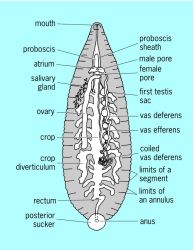If you would like to try this great lab please go to POOR LEECH!
In the lab, you first begin learning about the leech, or actually you start off by by using the leech tongs and try to grab the little parasite. You put the leech in 20% ethanol to numb it or in this case, knock it the heck out so it does not feel it's untimely death! Once you grab the leech from the ethanol, you place poor Leachey in the dissection tray. Poor Leachey, I had trouble pinning him down to the tray. I couldn't figure which side of him was his tail or his head....It looked the same! The big end is actually not the head....its the tail. So in the computer stimulation I was poking the poor leech's tail and not his head like 45 times before I FINALLY got the idea.
As I continued, I grabbed the scissors and managed to cut through the first layer of the leech (due to the angle of the scissors) and removed the inner tissue and guts of the leech and placed it under the disection microscope. I continued to romve certain parts of the tissue with the foreps into the light of the dissection microscope. If i did this in real life it seemed like the inside of the leech would seem much more well put then the stimulation gave. As you continued looking at the tissue and such of the leech with the microscope you press the tissue with a Oscilloscope which shows the voltage which can pass through the designated tissue and we can see which tissue responds to it and other stimuli such as a feather or a metal probe. YOu can see the reaction made with the Oscilloscope and the microscope and identify the tissue (ex: tissue t or s) It was difficult to identify the tissues as the would not respond to anything unless you found the exact spot the tissue responds too.
What I learned:
I learned that (as in the leech) has different muscles that react to different stimuli (in this case a feather, nothing, and electrical shock) and create different functions for each muscle to use. I also learned the leeches are parasites and can cause you to become sick due to the bacteria they carry in their mouth.
equipment:
Feather: Used to give the leech skin a very gentle touch stimulation. It really doesn't need to be a feather, it could be q-tips or something. Cost: free. | |
Probe: A blunt metal rod attached to a wooden handle useful for lifting, pushing, pressing, moving of specimen. Here you use it to lift tissue, and to push the skin as a stimulus. Typical price: $1.00 ~ 10.00 | |
Forceps: Fine forceps for very fine manipulations. The very fine ones are known as Dumont #5 forceps, with tip size of about 0.1 mm X 0.06 mm or smaller. Typical price: $15.00 ~ 45.00 | |
Scissors: Good dissecting angled scissors used here to cut open the body wall. Teaching scissors are cheaper, but some ultra-fine dissecting scissors could cost upward of $400, and you better not drop that, because once you drop it, chances are, it's ruined. Typical price: $15.00 ~ 60.00 | |
Pins: Stainless steel dissecting pins for pinning tissue to a dissecting dish or board. You can drop these and not worry about it. $1.00 | |
Scalpel: For microsurgery, disposable scalpel blades are better and much more economical than the fixed blade scalpel which needs to be sharpened periodically. Blade: $0.50 Handle: $10.00 Used here to cut all kinds of things. | |
Dissection Tray: A tray half-filled with hard wax so that you can stick pins into it to stabilize specimen for dissection. | |
Leech Tank: Leeches are kept in pond-water (you can actually buy an instant pond-water mix to add to tap water.) If kept in a refrigerator, they can stay happy in it for weeks at a time without feeding. | |
20% Ethanol: Used to anesthetize the leech. Besides being more humane, it has the added benefit that it stops them from moving, making it easier to pin down the leech. | |
Leech Tongs: These are basically gross anatomy forceps with blunt tips so that you will not harm the leech as you pick it up. Maybe about $ 10.00 | |
Dissection Microscope: These are binocular microscopes specifically designed for dissection and other micromanipulations. Essentially, it's a high quality high power magnifying glass. The price varies on quality and if you've looked through binoculars of different quality, you can appreciate what a difference good optic makes. On a good one, you can clearly see individual cells in a leech's nervous system. Cost about $1,000.00 ~ $7,000.00 | |
Micromanipulator: A device used to position items with sub-micrometer precision in three dimensions. Here we mount our electrode on it to guide it accurately to a neuron. For work on a leech, a mechanical manipulator would suffice which is about $700.00. More accurate hydraulic or electronic ones may cost up to $10,000.00 | |
Oscilloscope: Basically a sophisticated voltmeter. What you see on the screen is a real time display of voltage (vertical) plotted against time (horizontal). Useful because voltmeters can't track rapidly changing voltages, and even if they could, you couldn't read anything. Cost $2,000.00 and up. | |
Leech: Medicinal leeches are about $15.00 each. When fully extended, they can reach 15 to 20 cm long. When fully contracted, diameter is roughly 1 ~ 2 cm. |


